Synthesis of Blue Gahnite (ZnAl2O4:Co, Nd): A Cost-Effective Method for Producing Solar-Reflective Pigments for Cool Coatings
Abstract
:1. Introduction
2. Materials and Methods
2.1. Materials
2.2. Acid Digestion of Metallic Aluminum
2.3. Synthesis of Gahnite Pigments
2.4. Preparation of Pigmented Coatings
2.5. Characterization
3. Results and Discussion
3.1. Characterization of the Powder Pigments
3.2. NIR Reflectance Properties of the Powder Pigments
| Sample | Synthetic Method | Color Coordinates | Color from Color Coordinates | NIR Reflectance (R%) | Reference | ||
|---|---|---|---|---|---|---|---|
| L* | a* | b* | |||||
| CoAl2O4 | Commercial product | 44.8 | 2.1 | −32.7 |  | 29.0 | [6] |
| YIn0.9−xMn0.1Zn0.4O3−δ | Solid-state | 46.58 | 3.01 | −42.49 |  | 72.08 | [6] |
| Sr0.6Nd0.4CuSi4O10+δ | Sol-gel | 68.7 | −6.6 | −24 |  | 68.54 | [16] |
| Yin0.9Mn0.1O3-ZnO | Sol-gel | 49.94 | −0.88 | −40.55 |  | 70.0 | [33] |
| CaAl11.7Co0.1Ti0.2O19 | Solid-state | 64.89 | 3.88 | −40.30 |  | 69.22 | [15] |
| Zn0.9Co0.1Al2O4 | Combustion synthesis | 67.9 | −3.7 | −39.0 |  | 63.0 | [34] |
| Co-Gahnite | Coprecipitation followed by solution combustion synthesis | 43.83 | 11.86 | −34.39 |  | 62.04 | This work |
| CoNd-Gahnite | Coprecipitation followed by solution combustion synthesis | 45.36 | 8.12 | −36.89 |  | 63.01 | This work |
3.3. Coating Studies
4. Conclusions
Supplementary Materials
Author Contributions
Funding
Institutional Review Board Statement
Informed Consent Statement
Data Availability Statement
Conflicts of Interest
References
- Deepa, M.J.; Arunima, S.R.; Elias, L.; Bhagya, T.C.; Geethanjali, C.V.; Saji, V.S.; Aboobakar Shibli, S.M. BiVO4–TiO2 Composite-Based Zinc Phosphate Coating for High NIR Reflectance and Sustainable Energy-Saving Applications. Ind. Eng. Chem. Res. 2022, 61, 6481–6493. [Google Scholar] [CrossRef]
- Huang, B.; Xiao, Y.; Zhou, H.; Chen, J.; Sun, X. Synthesis and Characterization of Yellow Pigments of Bi1.7RE0.3W0.7Mo0.3O6 (RE = Y, Yb, Gd, Lu) with High NIR Reflectance. ACS Sustain. Chem. Eng. 2018, 6, 10735–10741. [Google Scholar] [CrossRef]
- Zinzi, M.; Agnoli, S. Cool and Green Roofs. An Energy and Comfort Comparison between Passive Cooling and Mitigation Urban Heat Island Techniques for Residential Buildings in the Mediterranean Region. Energy Build. 2012, 55, 66–76. [Google Scholar] [CrossRef]
- IEA. Space Cooling, IEA, Paris. 2022. Available online: https://www.iea.org/reports/space-cooling (accessed on 15 December 2022).
- Dong, S.; Quek, J.Y.; van Herk, A.M.; Jana, S. Polymer-Encapsulated TiO2 for the Improvement of NIR Reflectance and Total Solar Reflectance of Cool Coatings. Ind. Eng. Chem. Res. 2020, 59, 17901–17910. [Google Scholar] [CrossRef]
- Zhang, M.; Feng, L.; Zeng, Z.; Yang, Y.; Sun, X. Environmentally Friendly High-Near-Infrared Reflectance Blue Pigment YIn0.9−xMn0.1MxO3−δ Based on Li/Zn Doping. ACS Sustain. Chem. Eng. 2022, 10, 13877–13886. [Google Scholar] [CrossRef]
- Santamouris, M.; Synnefa, A.; Karlessi, T. Using Advanced Cool Materials in the Urban Built Environment to Mitigate Heat Islands and Improve Thermal Comfort Conditions. Solar Energy 2011, 85, 3085–3102. [Google Scholar] [CrossRef]
- Pisello, A.L. State of the Art on the Development of Cool Coatings for Buildings and Cities. Solar Energy 2017, 144, 660–680. [Google Scholar] [CrossRef]
- Zhou, W.; Liu, Y.; Sun, Q.; Ye, J.; Chen, L.; Wang, J.; Li, G.; Lin, H.; Ye, Y.; Chen, W. High Near-Infrared Reflectance Orange Pigments of Fe-Doped La2W2O9: Preparation, Characterization, and Energy Consumption Simulation. ACS Sustain. Chem. Eng. 2021, 9, 12385–12393. [Google Scholar] [CrossRef]
- Zhao, M.; Han, A.; Ye, M.; Wu, T. Preparation and Characterization of Fe3+ Doped Y2Ce2O7 Pigments with High Near-Infrared Reflectance. Solar Energy 2013, 97, 350–355. [Google Scholar] [CrossRef]
- Li, L.; Feng, L.; Xiao, Y.; Xie, W.; Sun, X. Synthesis and Characterization of Yellow Pigments (Li0.4RE0.6Al0.6)1/2MoO4–BiVO4 with High NIR Reflectance. ACS Sustain. Chem. Eng. 2021, 9, 16606–16616. [Google Scholar] [CrossRef]
- Rosati, A.; Fedel, M.; Rossi, S. NIR Reflective Pigments for Cool Roof Applications: A Comprehensive Review. J. Clean. Prod. 2021, 313, 127826. [Google Scholar] [CrossRef]
- Zheng, W.; Zou, J. Synthesis and Characterization of Blue TiO2/CoAl2O4 Complex Pigments with Good Colour and Enhanced near-Infrared Reflectance Properties. RSC Adv. 2015, 5, 87932–87939. [Google Scholar] [CrossRef]
- Ianoș, R.; Rus, I.; Lazău, R.; Păcurariu, C. Near-Infrared Reflective Ni, La-Doped Hibonite Pigments for Cool Blue Coatings. Ceram. Int. 2022, 48, 34428–34436. [Google Scholar] [CrossRef]
- Lv, K.; Zhu, Y.; Wang, L.; Chen, Z.; Zhang, Z.; Gao, Y. Codoping Ti in Low Co-Containing Hibonite Achieving Excellent Optical Properties for near-Infrared Reflective Pigment Applications. Ceram. Int. 2022, 49, 7387–7395. [Google Scholar] [CrossRef]
- Jing, J.; Zhang, Y.; Sun, J.; Zhao, X.; Gao, D.; Zhang, Y. A Comparative Study on Different RE-Doped (RE = Pr, Nd, Sm) SrCuSi4O10 Blue Pigments with High near-Infrared Reflectance. Dye. Pigment. 2018, 150, 9–15. [Google Scholar] [CrossRef]
- Gaudon, M.; Apheceixborde, A.; Ménétrier, M.; le Nestour, A.; Demourgues, A. Synthesis Temperature Effect on the Structural Features and Optical Absorption of Zn1−xCoxAl2O4 Oxides. Inorg. Chem. 2009, 48, 9085–9091. [Google Scholar] [CrossRef] [PubMed]
- Duell, B.A.; Li, J.; Subramanian, M.A. Hibonite Blue: A New Class of Intense Inorganic Blue Colorants. ACS Omega 2019, 4, 22114–22118. [Google Scholar] [CrossRef] [PubMed] [Green Version]
- Zhang, Y.; Zhang, Y.; Zhao, X.; Zhang, Y. Sol–Gel Synthesis and Properties of Europium–Strontium Copper Silicates Blue Pigments with High near-Infrared Reflectance. Dye. Pigment. 2016, 131, 154–159. [Google Scholar] [CrossRef]
- Schneider, C.A.; Rasband, W.S.; Eliceiri, K.W. NIH Image to ImageJ: 25 Years of Image Analysis. Nat. Methods 2012, 9, 671–675. [Google Scholar] [CrossRef]
- Horsth, D.F.L.; Primo, J.O.; Dalpasquale, M.; Bittencourt, C.; Anaissi, F.J. Colored Aluminates Pigments Obtained from Metallic Aluminum Waste, an Opportunity in the Circular Economy. Clean. Eng. Technol. 2021, 5, 100313. [Google Scholar] [CrossRef]
- Shaban, M.; Hosny, R.; Rabie, A.M.; Shim, J.-J.; Ahmed, S.A.; Betiha, M.A.; Negm, N.A. Zinc Aluminate Nanoparticles: Preparation, Characterization and Application as Efficient and Economic Catalyst in Transformation of Waste Cooking Oil into Biodiesel. J. Mol. Liq. 2020, 302, 112377. [Google Scholar] [CrossRef]
- Rojas-Hernandez, R.E.; Rubio-Marcos, F.; Gorni, G.; Marini, C.; Danilson, M.; Pascual, L.; Ichikawa, R.U.; Hussainova, I.; Fernandez, J.F. Enhancing NIR Emission in ZnAl2O4: Nd, Ce Nanofibers by Co-Doping with Ce and Nd: A Promising Biomarker Material with Low Cytotoxicity. J. Mater. Chem. C Mater. 2021, 9, 657–670. [Google Scholar] [CrossRef]
- Renaudin, G.; Gomes, S.; Nedelec, J.-M. First-Row Transition Metal Doping in Calcium Phosphate Bioceramics: A Detailed Crystallographic Study. Materials 2017, 10, 92. [Google Scholar] [CrossRef] [Green Version]
- Duan, X.; Yuan, D.; Yu, F. Cation Distribution in Co-Doped ZnAl2O4 Nanoparticles Studied by X-ray Photoelectron Spectroscopy and 27Al Solid-State NMR Spectroscopy. Inorg. Chem. 2011, 50, 5460–5467. [Google Scholar] [CrossRef] [PubMed]
- Rao Gurugubelli, T.; Babu, B.; Kim, J.; Yoo, K. Efficient Photoelectrochemical Water Oxidation and Electrochemical Supercapacitor Performance of ZnAl2O4 Hexagonal Microstructures. Mater. Lett. 2022, 313, 131812. [Google Scholar] [CrossRef]
- Huang, J.; Qian, W.; Ma, H.; Zhang, H.; Ying, W. Highly Selective Production of Heavy Hydrocarbons over Cobalt–Graphene–Silica Nanocomposite Catalysts. RSC Adv. 2017, 7, 33441–33449. [Google Scholar] [CrossRef] [Green Version]
- Cava, S.; Tebcherani, S.M.; Pianaro, S.A.; Paskocimas, C.A.; Longo, E.; Varela, J.A. Structural and Spectroscopic Analysis of -Al2O3 to -Al2O3-CoAl2O4 Phase Transition. Mater. Chem. Phys. 2006, 97, 102–108. [Google Scholar] [CrossRef]
- Duan, X.; Wang, X.; Yu, F.; Yuan, D. Effects of Annealing Temperature and SiO2 Matrix on the Structure and Optical Properties of Co-Doped ZnAl2O4/SiO2 Nanoglass–Ceramic Composites. J. Phys. Chem. C 2012, 116, 2313–2321. [Google Scholar] [CrossRef]
- He, X.; Zhu, W.; Wang, X.; Wang, F.; Liu, H.; Lei, Z. Synthesis and Color Properties of the CoAl2O4/Al2O3 Hybrid Blue Pigments with Low Cobalt Contents. J. Mater. Sci. 2020, 55, 13569–13577. [Google Scholar] [CrossRef]
- Elakkiya, V.; Sumathi, S. Ce and Fe Doped Gahnite: Cost Effective Solar Reflective Pigment for Cool Coating Applications. J. Alloy. Compd. 2020, 820, 153174. [Google Scholar] [CrossRef]
- Elakkiya, V.; Sumathi, S. Bismuth and Vanadium-Substituted Yttrium Phosphates for Cool Coating Applications. ACS Omega 2022, 7, 44266–44277. [Google Scholar] [CrossRef] [PubMed]
- Jose, S.; Jayaprakash, A.; Laha, S.; Natarajan, S.; Nishanth, K.G.; Reddy, M.L.P. YIn0.9Mn0.1O3–ZnO Nano-Pigment Exhibiting Intense Blue Color with Impressive Solar Reflectance. Dye. Pigment. 2016, 124, 120–129. [Google Scholar] [CrossRef]
- Ianoş, R.; Muntean, E.; Păcurariu, C.; Lazău, R.; Bandas, C.; Delinescu, G. Combustion Synthesis of a Blue Co-Doped Zinc Aluminate near-Infrared Reflective Pigment. Dye. Pigment. 2017, 142, 24–31. [Google Scholar] [CrossRef]
- Primo, J.D.O.; Correa, J.D.S.; Horsth, D.F.L.; Das, A.; Zając, M.; Umek, P.; Wattiez, R.; Anaissi, F.J.; Onderwater, R.C.A.; Bittencourt, C. Antiviral Properties against SARS-CoV-2 of Nanostructured ZnO Obtained by Green Combustion Synthesis and Coated in Waterborne Acrylic Coatings. Nanomaterials 2022, 12, 4345. [Google Scholar] [CrossRef]
- Zhang, J.; Zhu, C.; Lv, J.; Zhang, W.; Feng, J. Preparation of Colorful, Infrared-Reflective, and Superhydrophobic Polymer Films with Obvious Resistance to Dust Deposition. ACS Appl. Mater. Interfaces 2018, 10, 40219–40227. [Google Scholar] [CrossRef] [PubMed]
- Roppolo, I.; Shahzad, N.; Sacco, A.; Tresso, E.; Sangermano, M. Multifunctional NIR-Reflective and Self-Cleaning UV-Cured Coating for Solar Cell Applications Based on Cycloaliphatic Epoxy Resin. Prog. Org. Coat. 2014, 77, 458–462. [Google Scholar] [CrossRef]
- Yang, Z.; Xue, X.; Dai, J.; Li, Y.; Qin, J.; Feng, Y.; Qu, J.; He, Z.; Sun, P.; Xu, L.; et al. Study of a Super-Non-Wetting Self-Cleaning Solar Reflective Blue-Grey Paint Coating with Luminescence. Sol. Energy Mater. Sol. Cells 2018, 176, 69–80. [Google Scholar] [CrossRef]
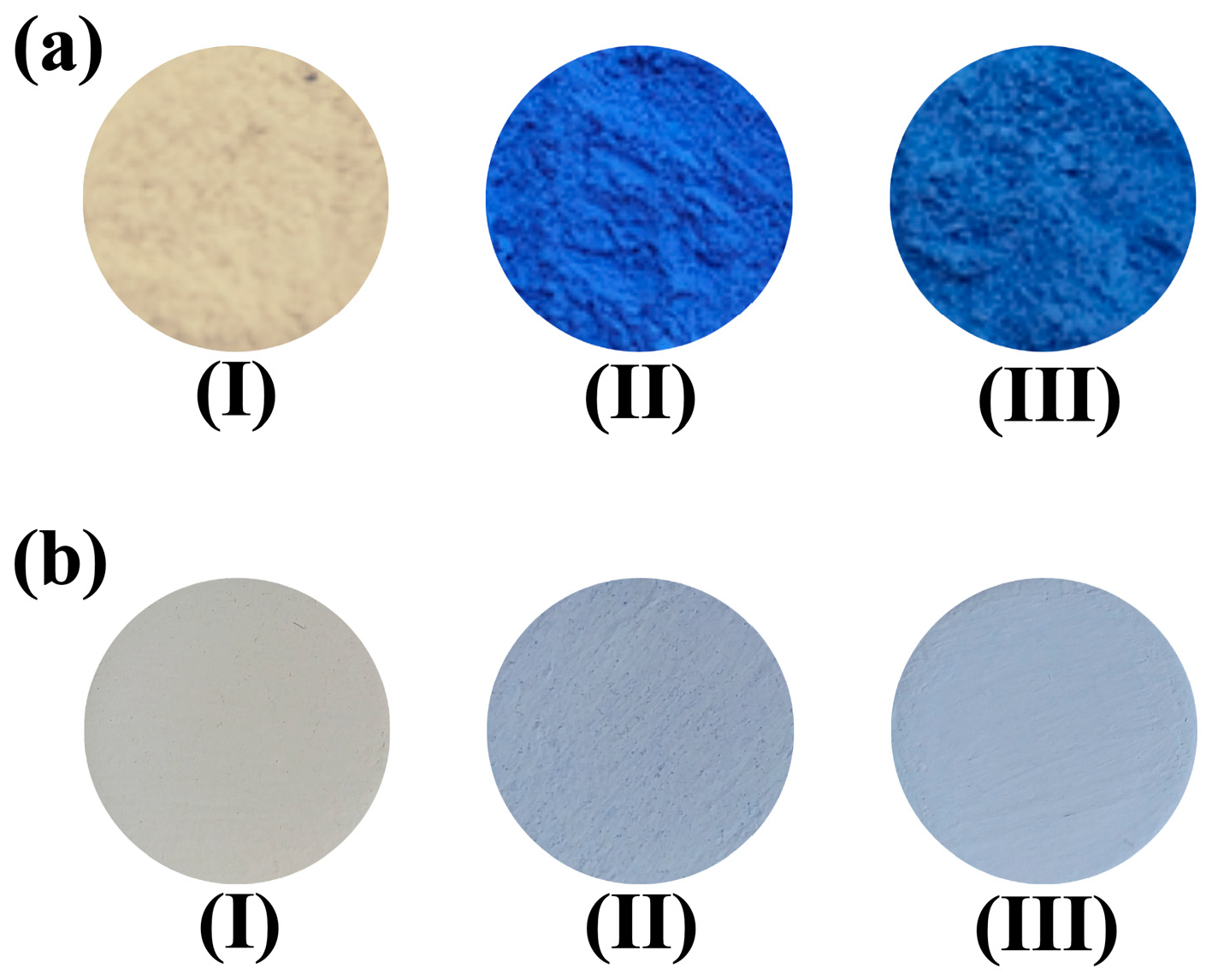

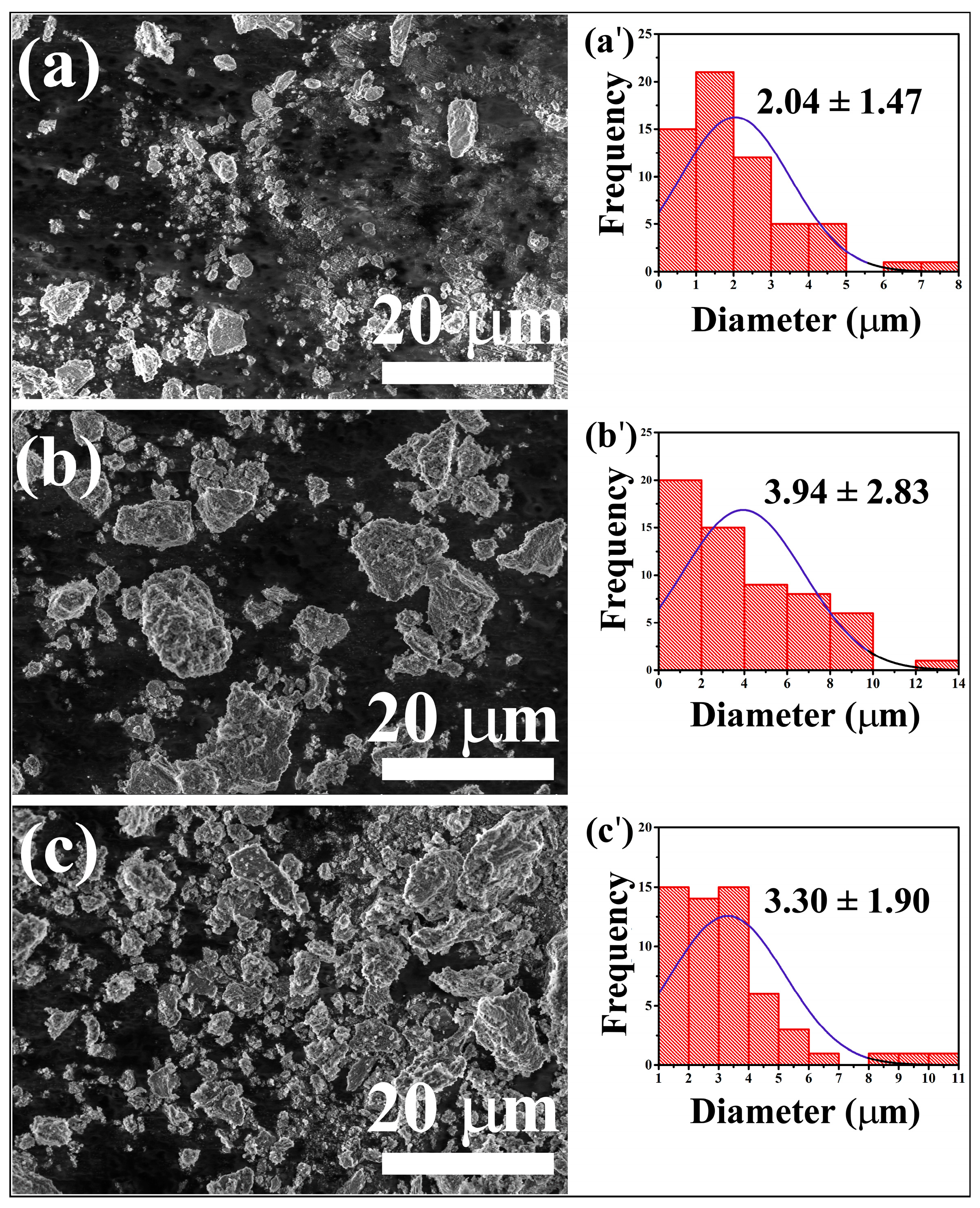
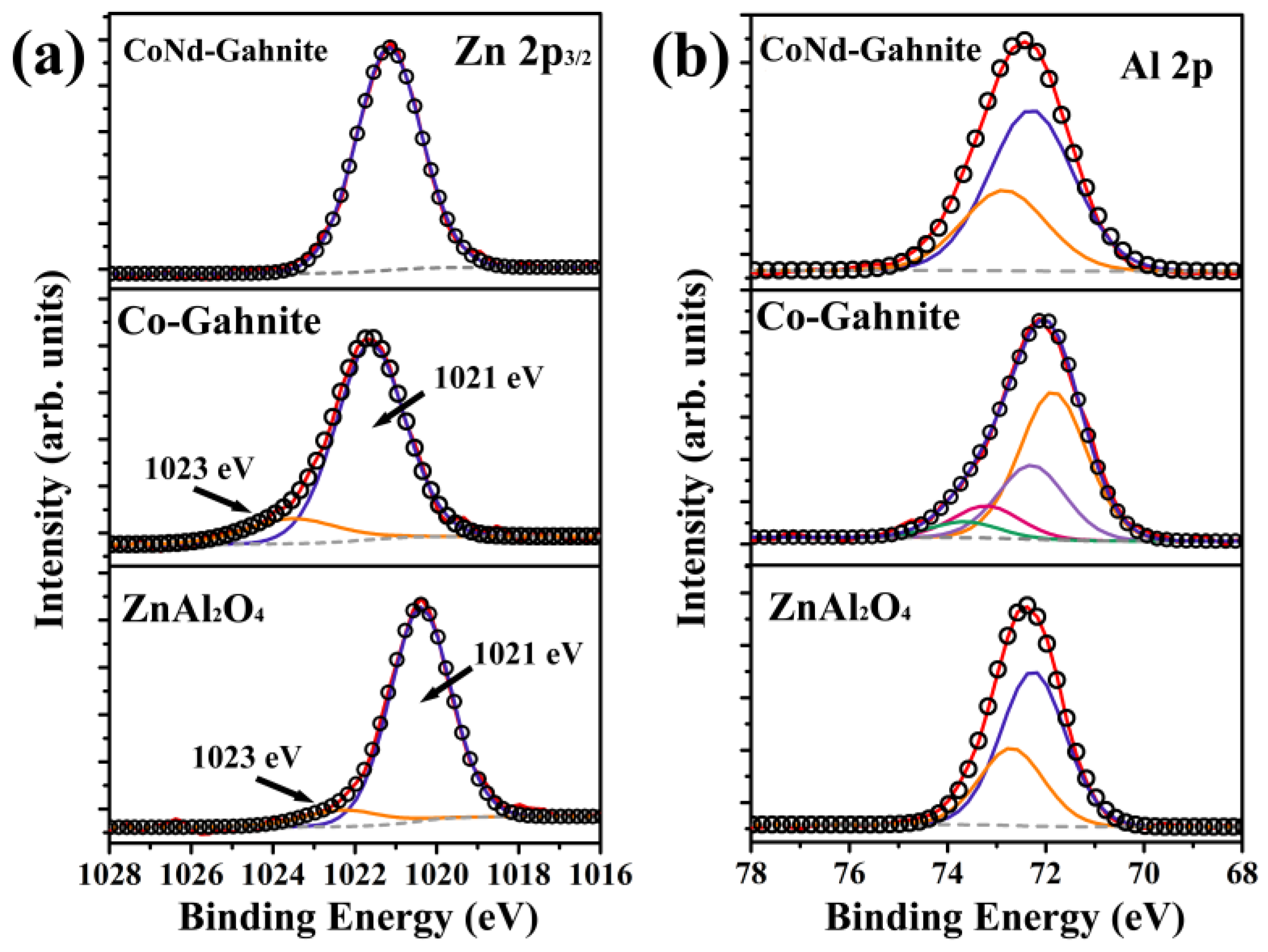
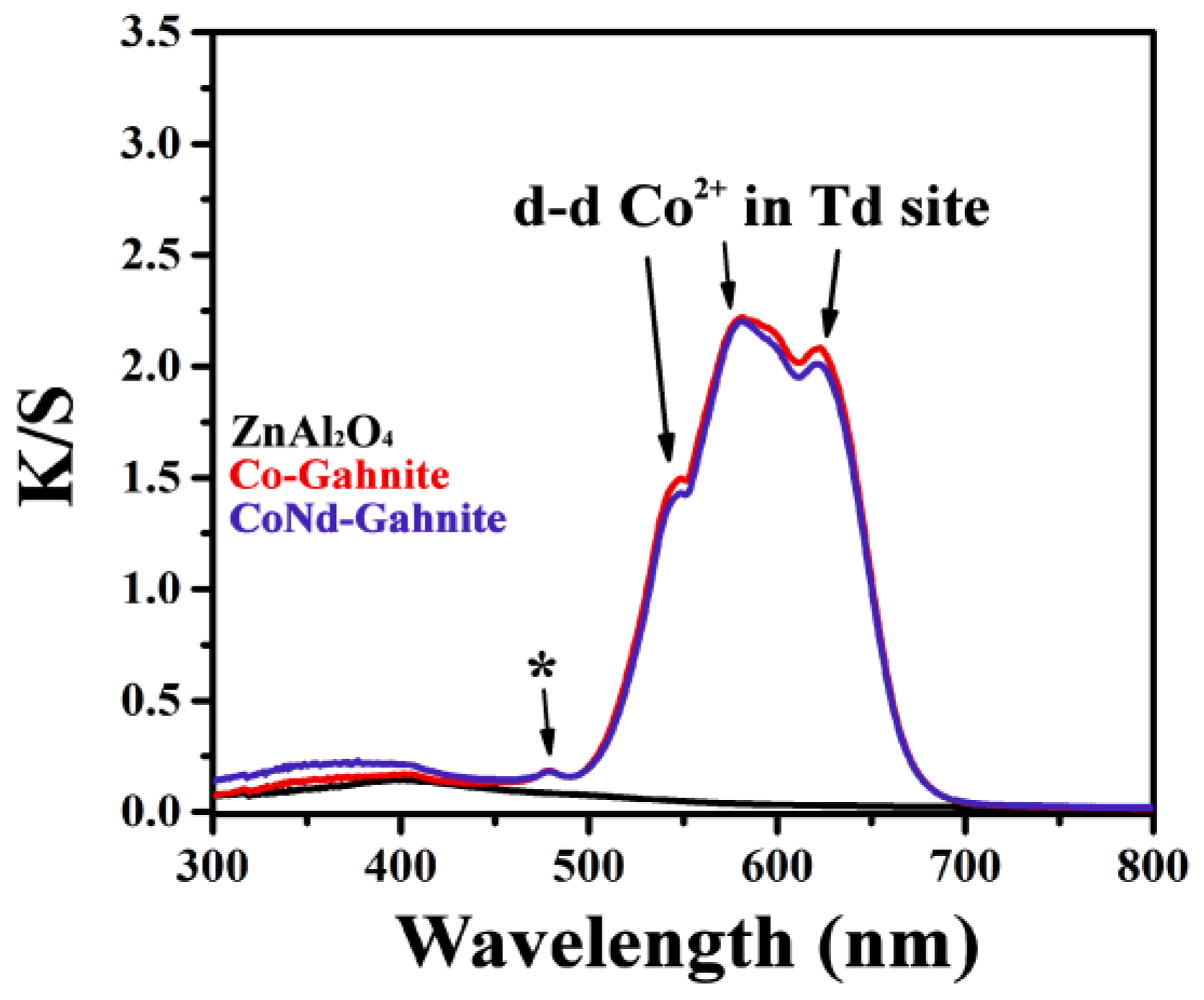

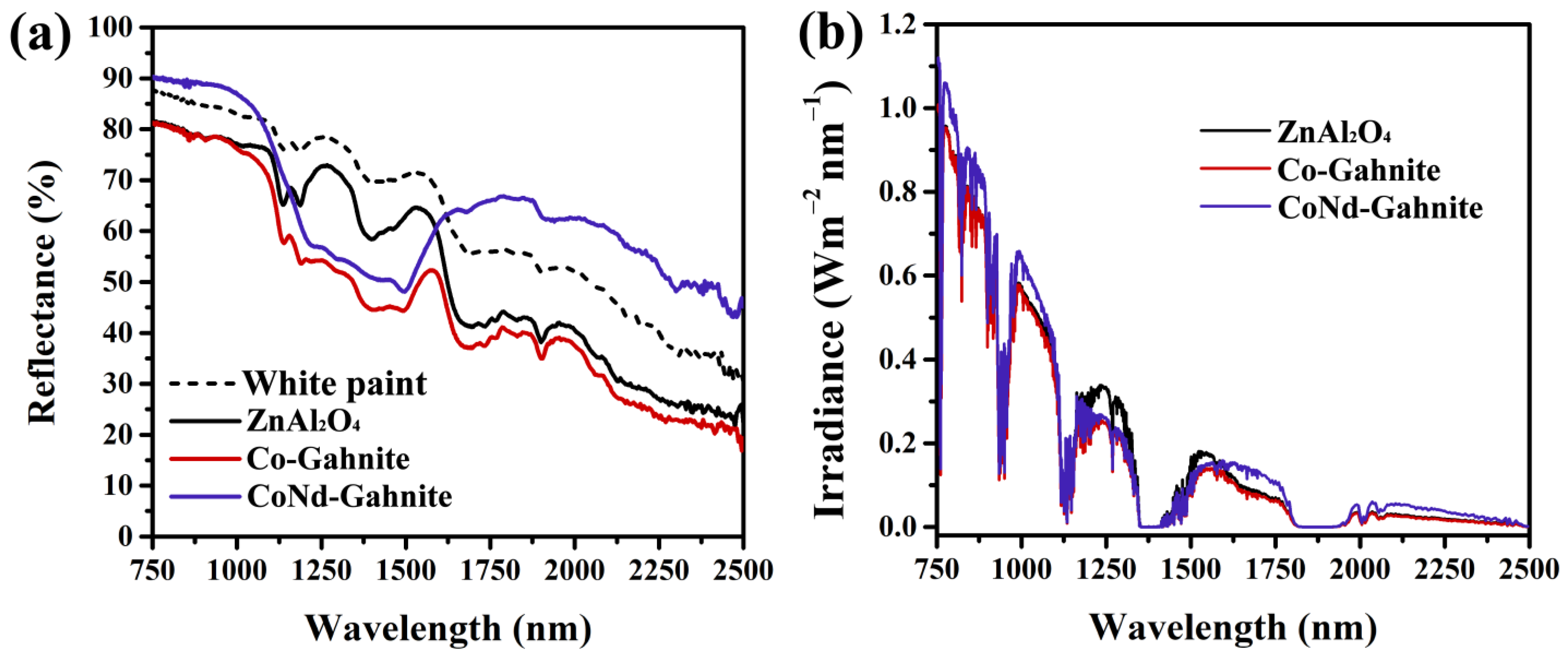
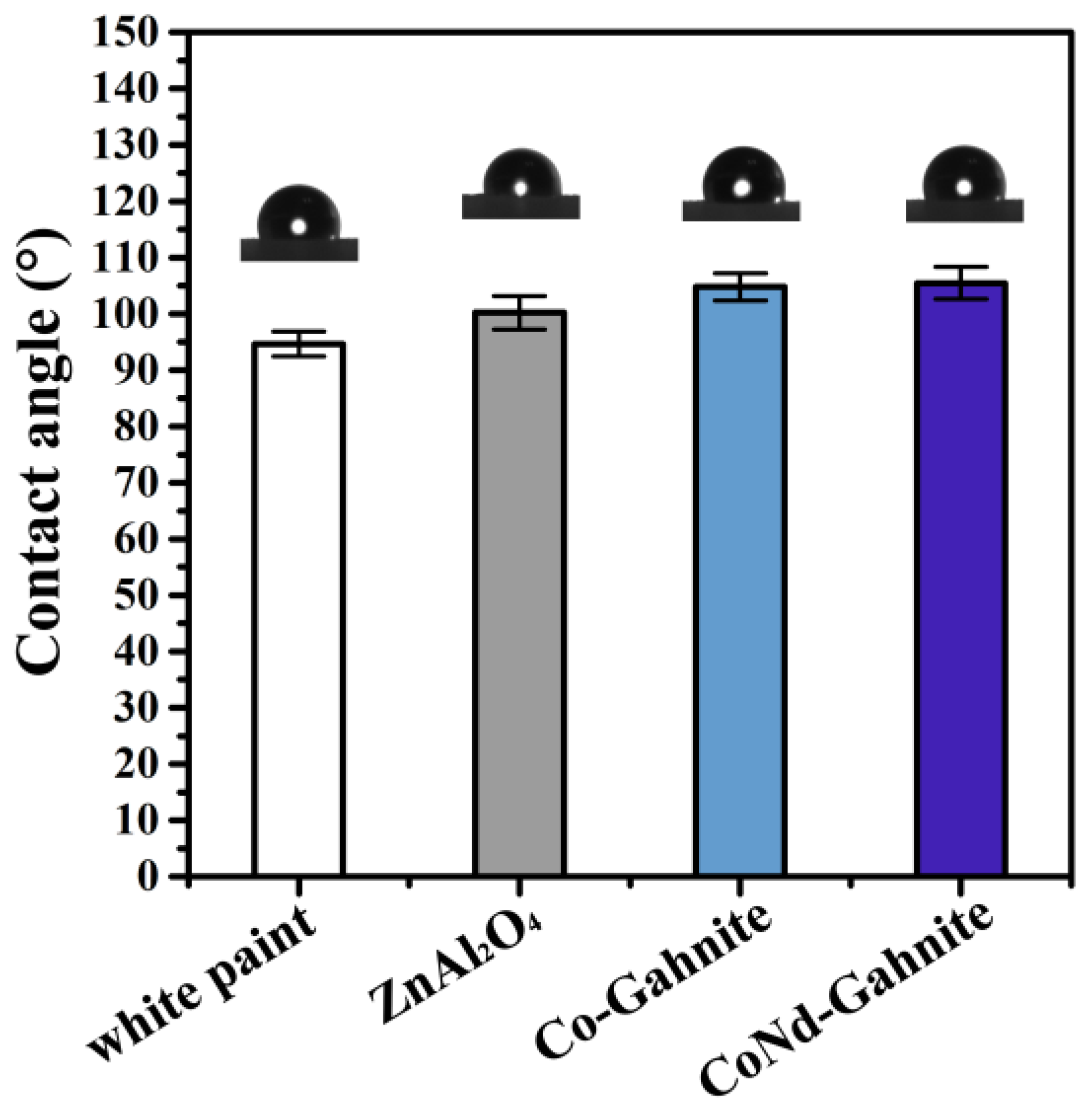
| Sample | Color Coordinates | Color from Color Coordinates | NIR Reflectance (R%) | ||
|---|---|---|---|---|---|
| L* | a* | b* | |||
| ZnAl2O4 | 79.63 | 5.15 | 12.45 |  | 81.75 |
| Co-Gahnite | 43.83 | 11.86 | −34.39 |  | 62.04 |
| CoNd-Gahnite | 45.36 | 8.12 | −36.89 |  | 63.01 |
| Sample | Color Coordinates | Color from Color Coordinates | NIR Reflectance (R%) | ||
|---|---|---|---|---|---|
| L* | a* | b* | |||
| ZnAl2O4 | 89.69 | 1.13 | 9.22 |  | 69.85 |
| Co-Gahnite | 67.13 | 2.00 | −27.09 |  | 64.97 |
| CoNd-Gahnite | 68.72 | −0.04 | −28.77 |  | 76.02 |
Disclaimer/Publisher’s Note: The statements, opinions and data contained in all publications are solely those of the individual author(s) and contributor(s) and not of MDPI and/or the editor(s). MDPI and/or the editor(s) disclaim responsibility for any injury to people or property resulting from any ideas, methods, instructions or products referred to in the content. |
© 2023 by the authors. Licensee MDPI, Basel, Switzerland. This article is an open access article distributed under the terms and conditions of the Creative Commons Attribution (CC BY) license (https://creativecommons.org/licenses/by/4.0/).
Share and Cite
Primo, J.d.O.; Horsth, D.F.L.; Balaba, N.; Umek, P.; Anaissi, F.J.; Bittencourt, C. Synthesis of Blue Gahnite (ZnAl2O4:Co, Nd): A Cost-Effective Method for Producing Solar-Reflective Pigments for Cool Coatings. Materials 2023, 16, 1696. https://doi.org/10.3390/ma16041696
Primo JdO, Horsth DFL, Balaba N, Umek P, Anaissi FJ, Bittencourt C. Synthesis of Blue Gahnite (ZnAl2O4:Co, Nd): A Cost-Effective Method for Producing Solar-Reflective Pigments for Cool Coatings. Materials. 2023; 16(4):1696. https://doi.org/10.3390/ma16041696
Chicago/Turabian StylePrimo, Julia de Oliveira, Dienifer F. L. Horsth, Nayara Balaba, Polona Umek, Fauze J. Anaissi, and Carla Bittencourt. 2023. "Synthesis of Blue Gahnite (ZnAl2O4:Co, Nd): A Cost-Effective Method for Producing Solar-Reflective Pigments for Cool Coatings" Materials 16, no. 4: 1696. https://doi.org/10.3390/ma16041696







